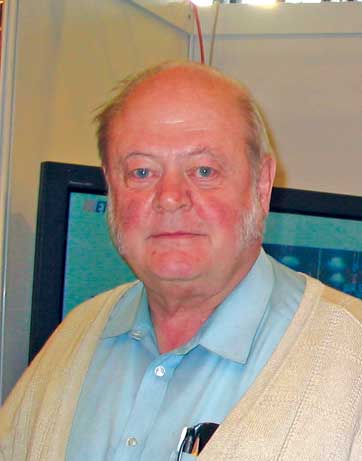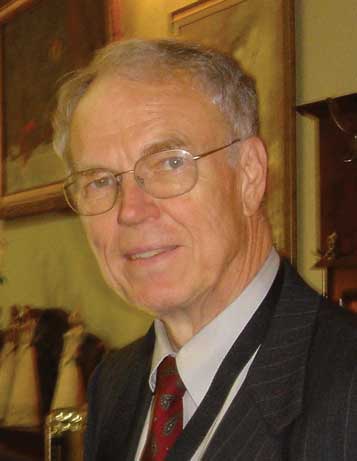 The
first time I met Carl Baum, a.k.a., the “Kaptain from Kirtland”,
was in an advanced EM graduate class at Caltech taught by our
advisor Dr. Papas. Carl had just arrived from the Air Force Weapons
Lab at Kirtland Air Force Base in Albuquerque, NM [now the Air
Force Research Laboratory (AFRL)] to finish his graduate work
at Caltech, where he had also been an undergraduate student. He
may even have worn his Captain’s uniform to class that first
day.
The
first time I met Carl Baum, a.k.a., the “Kaptain from Kirtland”,
was in an advanced EM graduate class at Caltech taught by our
advisor Dr. Papas. Carl had just arrived from the Air Force Weapons
Lab at Kirtland Air Force Base in Albuquerque, NM [now the Air
Force Research Laboratory (AFRL)] to finish his graduate work
at Caltech, where he had also been an undergraduate student. He
may even have worn his Captain’s uniform to class that first
day.
Much earlier, after a visit to Caltech, Carl’s father, who
was the assistant to the Chairman of the Board of Directors of
the Carrier Corporation, encouraged him to attend the institute.
Carl was well prepared to attend Caltech after his in-depth studies
at the Christian Brothers Academy in Syracuse, NY, which was highly
rated in academics and athletics. After graduating from Caltech
with a Bachelors degree, Carl joined the Air Force and was stationed
in Albuquerque.
Few may know that Carl played football in high school and played
the position of tackle on the Caltech football team (yes, they
actually have a football team, and I thought that the Kaptain
from Kirtland should also have been the captain of the Caltech
football team … think of the clever mathematical plays he
could have called and the team could have executed). “Dinosaur”
was his nickname in High School (a.k.a., Brontosaurus Baum). Now,
after graduating with a PhD degree from Caltech, I respectfully
call him “Doctor Dinosaur”.
Initially, not knowing that Carl had been a Caltech undergraduate,
I wondered what he would know about EM coming from the military,
which usually is more concerned about military tactics than technical
studies. I quickly learned that my first impression was totally
wrong. Carl’s understanding of EM phenomena was phenomenal.
In fact, he seemed to know “everything about everything”.
He certainly knew as much or more about the lecture topics than
his professors at Caltech and, in class, he added much insight
and many details to the lecture materials being presented. He
could also go into depth on new areas of research about which
the rest of the class had only a little understanding at that
time.
Even though Carl started one year behind me at Caltech, we graduated
the same year. In fact, he was many years ahead of the rest of
his class in theoretical understanding and in practical experience.
After graduation, Carl returned to AFRL and only recently retired
from the government to become a Distinguished Research Professor
in the Electrical & Computer Engineering Department at the
University of New Mexico (UNM).
As I reflect back on those graduate school days, I think that
in some sense my initial impression about Captain Carl was right,
because, unfortunately, I now believe that he did not learn anything
at Caltech … he knew it all before he came there!
As a member of the IEEE/EM Awards committee, I had encouraged
several of Carl’s colleagues to nominate him for this very
prestigious award. When the votes were in, I was not surprised
that Carl had clearly won the award for the many great contributions
he has made in the area of EM fields.
I am still amazed at the number of papers he writes each year
and the number of presentations he makes around the globe. His
extensive series of EMP notes, e.g., his interaction notes and
sensor and simulation notes, and several books contain many of
the seminal papers in the EM field. Carl has also been every generous
in supporting various scientific and educational activities in
the field of electromagnetics and has donated the monetary parts
of his scientific awards, plus additional funds, to the SUMMA
Foundation to benefit scientific endeavors.
On the non-technical side (yes, there is such a side to Carl!),
I have also had the distinct pleasure of listening to “Carl’s
Classical Compositions” as composed and played by him on
his grand piano at his apartment complex, which, incidentally,
he designed himself with his “hallmark” of no halls
inside the apartments. He also designed special diffraction patterns
into the stained glass windows and complementary color designs
into the stained glass lights that he made. Unfortunately, Carl
can no longer walk to work as he did at the Lab; UNM is too far.
But, he still has his trusty Corvair to convey him to work.
In summary, I am grateful for Carl’s longstanding friendship
all these years since our graduate school days. I have learned
much from associating with him and from his discussions with me.
Finally, I congratulate Carl on his well-deserved EM Award! I
also look forward to the EMC symposium in Hawaii in July when
the President of the IEEE will present this award to him.
But, I only wonder what Herr Prof. Dr. Ing. Baum will do with
the award plaque after he receives it. Just where will he put
it, since his UNM office walls are completely covered with the
many other awards he has received in the past? I end with that
question. Carl, the former Kaptain from Kirtland, will, no doubt,
have a good answer … as always. EMC
 Announcing
the Recipient of the 2007 IEEE Electromagnetics Award:
Announcing
the Recipient of the 2007 IEEE Electromagnetics Award: